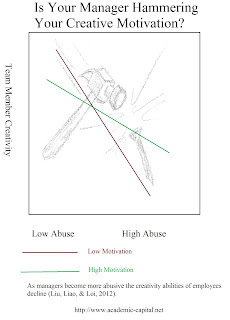Learning organizations are likely to be more
successful in developing new methods to compete on the market. Research by Michie
& Zumitzavan (2012) furthers the argument that those organizations that
foster learning and are managed by learning leaders are more successful than
those who are reactive and focused on pathological styles. Learning leadership
is progressive, open-minded, humanistic, and goal orientated that results in
higher firm development and profits.
Leadership and learning are two components that come
together to foster development. The way in which leaders learn has an impact on
how they act as administrators. Those that engaged in all four learning styles
action, thinking, feeling and assessing others are more capability of using
multiple leadership styles such as challenging, inspiring, enabling, modeling,
and encouraging (Brown and Posner, 2001).
Learning is one way in which organizations can
continually renew themselves versus accepting the fate of a rigid decline.
According to (Johnson and Scholes, 2002), organizations that are willing to
continue learning throughout their lifecycles become more sustainable in the
sense that they can adjust to new market trends, structures, and realities. If
such organizations are not willing to learn and change they will be eventually
crushed under new market realities by more competitive and nimble
organizations.
Leaders have the ability to prime the behavior of
their followers. When leaders have a healthy respect for learning they can
influence the expectations and behaviors of managers who further impact the
social structure of employees. Creating a culture that respects and fosters
learning, helps to enhance both the employees’ abilities, as well as the
ability of the organization to adapt to market changes.
The researchers Michie & Zumitzavan (2012),
attempted to see how the attributes of managers impacted the learning and
leading styles that influence organizational success. Twenty North Taiwanese
firms were selected for the overall interviews and questionnaires. They found that there was no relationship
between learning styles and the demographics of the organization or location. In
other words, learning leadership is not tied to organizational demographics. The
impact of organizational learning styles was influenced by the leadership
styles within the organization.
Effective
Organizations: Managers within effective organizations
believed that technology and cost reduction were two important factors.
However, they agreed that by developing employees skills their organizations
could be enhanced. Thus, they sent people to seminars, workshops, training,
educational outlets, etc… to improve their skills. They welcomed open opinions,
managed workplace problems progressively, delegated for employee enhancement,
and continued to forecast the needs of their organizations into the future.
Less
Effective Organizations: Less effective organizations are
marked by their short-sighted thinking that focused on day-to-day issues. They
were less able to forecast the future of the organization or able to solidify
the goals of the organization. They rarely sent people for enhancement training
or education and did not do well in managing employee problems. Furthermore,
they were not willing to delegate authority and did not encourage employee opinions.
The research results indicate that short-sighted behaviors,
whereby individuals are not learning, are more prone to poor performance. With such
results it is important to understand how training and development has an
enhanced place in the most successful organizations. Such training doesn’t need to be formal but
does need to encourage constant learning and development to be effective. The
learning style of the leaders and their level of expectation setting appear to
foster organizational learning.
Micromanaging leads to poor results and creates a
systematic structure that damages the organizations ability to effectively
compete on the market. Some have argued that micromanaging is a pathological
behavior rooted in the manager’s childhood experiences, perceptions of incompetence,
and their inability to think beyond their most immediate needs. Such managers
foster fiefdoms in the workplace, manage by fear, and often take credit for
others work. Many times their policies, procedures, and departmental approaches
are based in the need for self-validation. For investors and executives who
desire to see their organization succeed, they should take considerable care in
fostering learning within their organizations and limit the advancement of
those with the least capacity to lead. New ideas bring opportunities for
organizational advancement. Where profits are low, adaptation slow, and
employee development under toe….you may just have an abundance of pathological
management styles.
Brown, M. and Posner, Z., (2001).
Exploring the relationship between learning and leadership.
Leadership
and organizational development journal, 22 (5–6), 274–280.
Johnson, G. and Scholes, K.,(2002). Exploring corporate strategy. Essex:
Pearson Education.
Michie, J. & Zumitzavan, F. (2012). The impact
of learning and leadership management styles on organizational outcomes: a
study of Tyre Firms in Thailand. Asia
Pacific Business Review, 18 (4).
